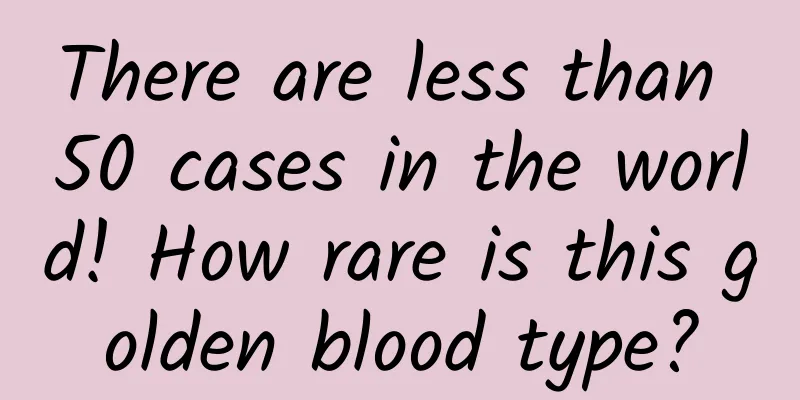There are less than 50 cases in the world! How rare is this golden blood type?

|
Audit expert: Jin Tao Chief Physician of Hematology Department, Shenyang Red Cross Hospital Some time ago, I saw a news report that a female patient was admitted to a hospital in Jiangsu. During the blood type test, it was found that she had the rare "golden blood type"! Source: Weibo screenshot What is the golden blood type? Is it the commonly known panda blood? Or is it the "universal blood type" O blood type? Today we will talk about the secrets of blood types~ Origin of blood type Before explaining the classification of blood types, I would like to introduce to you how humans discovered blood types . In 1900, an Austrian pathologist named Karl Landsteiner discovered that some plasmas could actually make red blood cells coagulate while others could not while studying blood fusion with his colleagues. After careful screening and experiments, they finally determined the three blood types of the human body, namely A, B, and O. Two years later, his students discovered AB blood type. Karl Landsteiner's research provided powerful theoretical guidance for blood transfusion safety in later generations, and also won him the Nobel Prize in Physiology. Afterwards, the day he was born was designated as "World Blood Donor Day." What does blood type mean? In fact, blood type refers to the type of antigens on the surface of blood components (including red blood cells, white blood cells and platelets). At present, there are more than 30 blood type systems recognized by the International Society of Blood Transfusion (ISBT), and the more familiar ones are the ABO blood type system and the Rh blood type system. The ABO blood type system divides blood into type A, type B, type O, and type AB based on the presence of antigen A and antigen B on the red blood cell membrane. If there is only antigen A on the red blood cell, it is type A; if there is only antigen B, it is type B; if it contains both antigen A and antigen B, it is type AB; if there is no antigen, it is type O. Source | pixabay The Rh blood type system is based on the presence of the "RhD" antigen on red blood cells, and includes negative and positive blood types. Rh negative blood is very rare and is also called "panda blood". The Rh blood type system coexists with the ABO blood type system. Regardless of whether you are type A, type B, type O or type AB, as long as the "RhD" antigen is not present on your red blood cells, you have Rh negative "panda blood". Source: unsplash The golden blood type we mentioned at the beginning can be said to be an "enhanced version" of panda blood. In addition to the negative RhD, the antigens RhC, Rhc, RhE, and Rhe are also negative, that is, RhNULL blood type. Why is this blood type given the meaning of "gold"? Because it is so rare! The probability of golden blood type appearing in the population is only one in six million. Since the golden blood type was first discovered in 1960, there have been less than 50 cases in the world, and only four cases have been reported in China, which is enough to show how rare and precious it is. Inheritance of blood type A person's blood type is innate, and the key to determining blood type depends on whether the genes carried by the blood types of both parents are dominant or recessive. The ABO blood type gene mainly includes three alleles , namely IA, IB and i. Among them, IA and IB can catalyze the synthesis of antigen A and antigen B respectively, while i cannot catalyze the synthesis of antigen A and B. Because human chromosomes are diploid, usually a person can only inherit one allele from each parent. Since IA and IB are dominant to i, and IA and IB are co-dominant, if a person's genotype is IAIA, he or she is type A blood, and if his or her genotype is ii, he or she is type O blood. In a family, the blood types of parents and children conform to this genetic law. For detailed classification, please refer to the table below. Even if both parents are type A and type B, it is possible to give birth to a baby with type O blood. Source: Baidu Encyclopedia The above genetic chart is valid in most cases, but there are exceptions in rare cases, such as (Cis) AB blood type. This blood type is expressed as AB type in ordinary blood typing. Children whose parents are O type and (Cis) AB type will be O type or AB type. Identification and use of blood typing Now that we understand the classification and inheritance of blood types, how do we identify blood types? There are two commonly used detection methods in clinical practice, namely the hemagglutination test and the microcolumn gel test . The hemagglutination test is to determine the blood type by observing the agglutination reaction of antigens and antibodies in the blood in the liquid. The microcolumn gel test is to react the red blood cell antigens with the corresponding antibodies in the medium formed by the microcolumn gel, and observe whether they can pass through the gel molecular sieve after centrifugation to identify the blood type. In addition, there is now a way to identify the genotype through saliva testing, thereby determining the blood type. Source | pixabay In actual application, because different blood types are mutually exclusive and will produce hemolytic reactions, the principle of "same-type blood transfusion" must be strictly adhered to during blood transfusion, that is, type A blood is transfused to type A blood patients, and type B blood is transfused to type B blood patients. There are rumors online that "O-type blood" is universal blood, but this statement is actually not accurate. Although O-type blood does not have antigen A and antigen B, the plasma of O-type blood contains antigen A agglutinin and antigen B agglutinin. If O-type whole blood is transfused to A, B or AB type patients, hemolysis is also likely to occur. Currently, suspended red blood cells (O-type red blood cells with most of the plasma removed) are generally used for blood transfusion rather than O-type whole blood. Regarding the requirements for blood donors, according to the "Health Examination Requirements for Blood Donors" issued by the National Health Commission, only people who meet the requirements of hemoglobin ≥ 120g/L in male blood and ≥ 115g/L in female blood can donate blood. In addition, people with anemia or underweight are not recommended to donate blood. The specific situation should be further confirmed by consulting the on-site doctor. Source: unsplash In short, whether it is ABO blood type, golden blood or panda blood, the different classifications are mainly for safer blood transfusions, and there is no other distinction between good and bad. There is often a saying on the Internet that "some blood type is prone to disease", but there is currently no research to prove that blood type has a direct relationship with health. There are many reasons why everyone gets sick. Instead of worrying about whether it is due to blood type, it is better to go to the hospital for treatment. However, it is also good to know more about blood type so that you can have more topics to talk about. |
>>: Knowing these things, fish will taste even better!
Recommend
Fan value report of 4 major platforms: teach you how to do well on Weibo, WeChat, Douyin and Xiaohongshu!
In the era of traffic, the importance of fans is ...
Xpeng Motors announces completion of Series A+ financing, with Alibaba becoming the fourth largest shareholder
[NetEase Intelligence, December 15] Today, He Xia...
E-commerce platform HighstreetWatchApp
Source code introduction: This project is an appl...
How to operate a good community?
Introduction: Although all operations have common...
Insights into e-commerce information flow advertising in 2019!
The transaction volume of the Double Eleven battl...
AI meets obsessive-compulsive disorder, solving the rift between the brain and emotions
As the New Year is coming to an end, many people ...
It can grow up to 2 meters and live up to 100 years. It is not a python but a fish... Its bite is not very painful, but it is very scary.
Do you know what this fish called "river mon...
Rabies mortality rate is 100%? Will people still be allowed to keep dogs?
This article was first published by Hey Stone Hea...
Is taxi-hailing software experiencing a “new life”?
The Ministry of Transport recently officially issu...
Is iOS 15 just a better-looking Linux?
[[404375]] Although iOS has reached its 15th vers...
How to use product thinking to look at the problem of Didi taxi being difficult and expensive?
User psychological expectations are a process tha...
The most comprehensive Zhihu operation and promotion skills!
There is strength in numbers, and more firewood m...
Latest research: Will intermittent fasting cause baldness? Scientific maintenance methods revealed!
As a popular diet, intermittent fasting has attra...
Do barnacles and lice make whales itchy? How do whales scratch themselves?
Let’s talk about the second form first. Scratchin...









